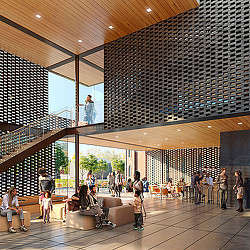Creating a Range of Entry Points to Engage New Museums Audiences
Our Culture & Museums and Entertainment and Experience Design leaders to discuss what’s next for museums and cultural spaces.

As museums and cultural institutions continue to face challenges around rising operating costs, dwindling donations, lower visitation levels, and decreased revenue, they’re finding new ways to reach and grow new audiences. Whether an immersive installation in a permanent collection for a fine art museum or a quieter pop-up in a public space, having a diverse mix of new experiences is crucial to engaging the next generation of potential visitors, donors, and participants.
We sat down with Bevin Savage Yamazaki, co-leader for Gensler’s Culture & Museums practice, and Ann Morrow Johnson, leader for Gensler’s Entertainment and Experience Design Practice, to discuss how museums and cultural institutions can increase engagement, interactivity, and play.
What changes are you noticing in the culture and museums space with regards to engagement or invitation?
Ann Morrow Johnson: Cultural institutions and museums are experiencing a bit of an identity crisis, where they’re asking, how do engage with new populations who might have previously felt excluded from the institutional space? How do you invite people to participate and engage, beyond pure education? There’s a real effort to engage with new populations. What might that mean for where the cultural sector is going in the next 10-20 years?
Bevin Savage Yamazaki: So much of it is about providing a range of entry points. How you arrive at the museum, how that entry experience makes you feel like you belong. Then when you move through the museum you feel connected and engaged. That’s really a key part of reimaging the museum as a true community space.
How do you integrate younger, disparate, intergenerational audiences into exhibitions and experiences?
BSY: We are seeing newer generations moving away from the old school polemics of label reading and interpretation; they are drawing parallels with our current culture and finding new meanings that are youth culture tangential. Much of this is crafted through a self-guided experience that is personal, topical, and relatable.
AMJ: That mimics what we’re seeing in the way that people are engaging with anything in culture right now. You see this movement away from traditional movies or films and into the rise of gaming; there’s an expectation of participation and interactivity, rather than just being a passive receiver of information.
Inviting someone to interact with an exhibit is really different than inviting them into a semi-spiritual, quiet moment. If you think about quiet, smaller, darker spaces versus more expansive ways to read, play, and discover something more tactile — there are any number of different ways to invite someone to engage with something, and the way you extend the invitation can often affect the way they interact with the object, the exhibit, or the space.

BSY: One of the beautiful things about a truly successful museum experience is having those moments of respite. There does seem to be a trend in today’s youth culture to seek out technology-free experiences — reading physical books, or standing in front of a painting without seeking an accompanying technical experience. Museums can be that place that takes you out of our technology-heavy life with all its sensory overload and into a quiet and personal moment of submersion into art. Not everything needs to be about technology.
AMJ: Technology is a tool for design. It’s about setting up a relationship with the thing that you’re doing, and viewing everything from lighting to space to sound to music to digital interfaces as tools for crafting the moment.
Part of crafting the moment is designing an experience that allows people to focus on the moment itself and not everything else. How do we remove the friction points? The moments of frustration? There’s a tremendous amount to be learned from emerging trends from other sectors here: entertainment, hotels, airports, etc. in how to remove the pain points of entry, ticketing, and flow. These aspects are critical to visitor comfort so that they can free up the brain space to focus on the heart of the experience.
BSY: New York’s Museum of Modern Art (MoMA) is a great example of that ease of visitor experience. There are several ways to get your ticket: pre-purchased, in the museum via a kiosk, or in the museum via a staff member, and then you move into a bright open and welcoming lobby that gives you space to sit and plan your visit and choose whatever path you wish to take. We really thought through the entry experience to ensure that first experience of the museum feels generous and easy to navigate.

How do you think about the role of museums and culture with regards to engagement, education, and stewardship?
AMJ: I hope that the museum and cultural space can be a place that fosters dialogue, reflection, and engagement in a way that allows for curiosity, and being open to new information, a different point of view, or a new understanding. So much of this is about how museums and cultural spaces can tap into the visitor, the donor, or the participant to find new, even more playful ways to engage and experience the sense of awe or wonder that ultimately leads to respect for these places and things that so many folks have dedicated their lives to stewarding, preserving, and championing.
How do you think about the idea of permanence vs. ephemeral experiences in the distribution of exhibits?
BSY: Historical objects and art have so many opportunities to be viewed through a range of different lenses. There is something extraordinary about the longevity of the storytelling and how it can be authentically recontextualized through the lens of current culture and how these art pieces can be ‘reinvented’ by layering in the spirit of the day. I believe in the ongoing ephemerality of the story, the interpretation of art as it’s reborn in each new generation.
AMJ: As your context changes, the lens through which you view a static piece changes. The recent renovation of the National Portrait Gallery in London does such a beautiful job of this, where you see two seemingly disparate but similar thematic moments that allow you to confront your own conception of a piece differently in a really lovely way.
There are tools that make something feel like it has importance or grandeur in a timeless way, versus things that can be done in a more temporary installation. For example, at the Temple of Dendur exhibit at The Met in New York, there is something deeply experiential about the exhibits regardless of whether they are permanent or temporary; it’s about how they create a personal relationship with the audience member or viewer.
In a world of changing funding sources for culture and museums, how does the idea of engagement affect or become affected by these changes?
AMJ: The fact that we are seeing so much change in the funding and finance mechanisms for museums and culture necessitates a change in thinking around engagement with potential future visitors, donors, and guests. We have to meet people where they are, using tools to design spaces, exhibits, and museums in a way that will be impactful.
Using learnings from other sectors to get people to participate in these spaces is going to be critical, not just for how people engage with specific exhibits or spaces, but also in the way that you can create calls to action for potential guests to participate and feel a sense of ownership.
BSY: One great example is the Jackie Robinson Museum in New York, where an interactive wall encourages the visitor to pledge their involvement to social activism. This idea of the museum as a driver of soft power within our communities is powerful and an opportunity for spaces of culture to drive community engagement and participation. Institutions can do this by ensuring their mission is clearly interwoven throughout the space, through the architecture, exhibitions, and the stories being told.

What other opportunities do museums have to engage with new audiences, especially younger generations?
BSY: Younger audiences often are expecting a level of interactivity in the gallery and museum spaces. While it’s not necessarily about more touch screens and more tools, it is about creating ways to connect and engage with art in a way that’s crafted and self-curated by them, and not just by the museum. I think the critical question is, how can we deepen the visitor’s connection with the exhibition, the stories, and the museum in a way that doesn’t dilute the institution’s mantel?
If we go back to the role of a museum, it is certainly a place to have unexpected experiences, a place to socialize and gather, but at its heart it is a place of education. And so, ensuring that rigor remains, as we see an expansion into more immersive storytelling and experiences, and keeping that focus content and learning is key to maintaining the true role of these institutions as an educator.
For media inquiries, email .










